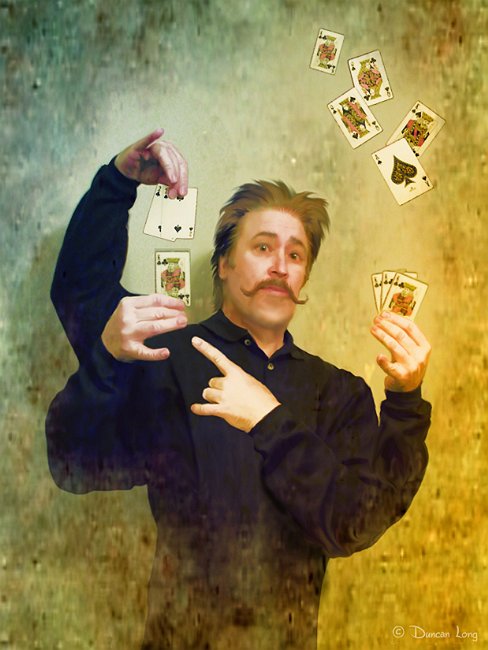Shoving Electrons With a Digital Tablet
filed in Book Cover Illustrations and Artwork on Aug.15, 2009
I know some digital artists do excellent work using a mouse. But I have found that a quality graphics tablets can be a great asset to some types of artwork, especially paint programs. And I can’t imagine trying to tackle some of my book illustrations without a graphics tablet.
I had to do a lot of soul searching years ago before shelling out all my cold, hard cash for my first graphics tablet about ten years ago. I tried a lot of cheap substitutes before finally shelling out for a quality product: Pens with tiny trackballs built in, various pointing devices, and other odds and ends. Then I finally broke down and bout a Wacom tablet which had (and still does have) the best reputation among digital artists.
That first Wacom tablet was purchased for several hundred bucks less than list price because it was a factory refurbished unit. It worked perfectly, and continue to work without a hit for the next ten years, with the help of packing tape around the occasionally shorting cord where it went into the tablet, and the finish on the plastic drawing area which wore into grooves (a little sandpaper fixed that). I’d still be using that tablet today if my computer upgrade had had a serial port to accommodate it, or a free slot to plug a serial port card into. Alas, even though it is one super-duper system, no extra cards (hey, Hewlett Packard, how about cutting power users a break?).

When I first started using that first tablet, I had some second thoughts. And it took a few calls to customer support to get it up and running (my new unit plugged into a USB slot and was running right from the start). Finally my Windows 95 system accepted it and after a little awkward practice that seemed to say, “not much better than a mouse” there was a moment when the drawing became more natural and less stressful and then things clicked and – I would never go back to trying to draw with a mouse.
In fact, I’d rather go to a slower computer than give up my tablet, and that’s saying a lot because I am not a patient man when it comes time to process an illustration or render a landscape. (Hopefully the culture Nazis won’t break down the door and torture me with this decision of which I must give up.)
My old Wacom continued to work through upgrades to W98 and XP. It has outlasted my other hardware, going through three different computers before I got my new system six months ago. I’ve kept it and an old computer as my “emergency spares” in case I need to get up and running after a disaster with my current system.
Some graphics programs aren’t suited for a tablet. Photo-Paint 8 (which has been my main paint program for about ten years as well) never has worked well with the pressure-sensitive features of the tablet. That has not been a big loss; when I’ve had that with other paint programs I’ve found I didn’t need it that much. Once a pen and ink man, always a pen and ink man, perhaps.
Generally 3D program designers seem never to have heard of a digital tablet, near as I can tell. Z-Brush works well with a digital tablet, but Poser, Vue, and the others can go into a tailspin when you try to run them with a pen. But paint programs… Here the tablet shines and becomes more of a digital paint brush or spray can than pen and tablet.
I keep thinking perhaps some competitor will come along and give Wacom a run for its money. But that hasn’t happened. There are other digital tablets out there, but they really don’t seem designed, as of yet, for serious artwork.
Wacom also offers a tablet system that works directly on a screen. Marketed as the Wacom Cintiq Pen Display, it has a display that the user works on – very much like working on a canvas or sketch pad.
I suspect that this is great for some artists, and it probably makes the transition from real sketching to working in a digital environment a lot faster. Personally, but after working on a tablet PC for several years, I wouldn’t care to give up my tablet and large monitor for the Cintiq Pen Display (though if anyone were giving them away, I’m sure I’d take one). For one thing, putting a tablet where you want it is a lot easier than moving an entire screen/tablet system around. And if something goes wrong with my monitor, it is a lot cheaper to replace than is a one-piece tablet/monitor system.
Beyond that, however, there is the fact that a hand drawing on the monitor blocks out a large section of the screen. It sort of turns you into a lefty who has trouble writing because his hand is blocking the line. A tablet gives you an “invisible hand” on the screen and I much prefer that to covering up part of the screen with my hand.
If you’re an artist serious about your digital artwork and use a paint program (Photoshop, Photo-Paint, Paint, etc.) then my advice is to run, not walk, to the nearest retailer and buy a Wacom tablet. The Wacom Intuos4 Medium Pen Tablet is a good choice. (Wacom also offers the Bamboo Fun Tablet
, but I would advise going for the Intus line as they’re better suited to graphics work.)
After you’ve worked with a tablet a bit, I’m betting you’ll discover it has given you a big leap forward in your technical skills.
Publishers interested in purchasing the rights to this illustration for use as a book cover, magazine illustration, etc., (or anyone with suggestions, or whatever, please contact me).
Comments Off on Shoving Electrons With a Digital Tablet